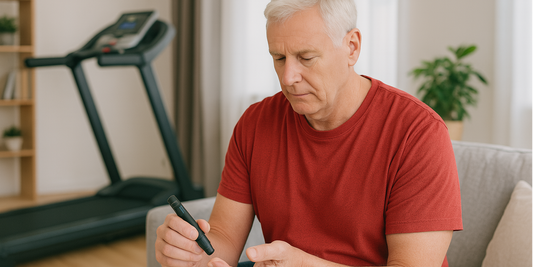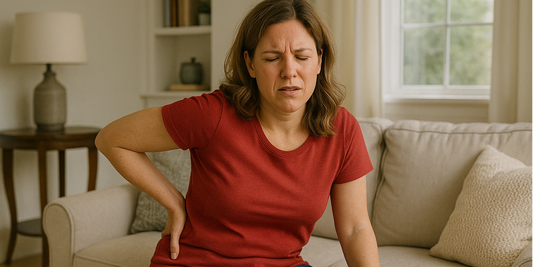
When and How to Safely Resume Your Workout After Being Sick (+ 6 Key Steps)
Share
"Listen to your body's whispers before they turn into screams," is a piece of advice that resonates strongly when it comes to returning to your workout routine after being sick.
When you're recovering from an illness and are eager to jump back into your fitness routine, remember it's not just about the ability to power through a workout. It's equally important to make sure your body is truly ready to face the physical demands again. Overlooking these signals can not only slow down your recovery but might also push you into further health issues.
So, it’s essential to give your body the respect and time it needs to heal completely before you start exercising again. Making sure you're fully recovered is the best strategy for safely getting back into your fitness routine.
Can I Exercise If I'm Feeling Sick?
Deciding to exercise when you're not feeling 100% can be a difficult decision. A few sniffles or a mild cough might not need to derail your exercise plans. Yet, there's a simple guideline to help you make the decision: the "neck rule."
Experiencing symptoms like sneezing or a minor sore throat? These, generally located above the neck, usually don't interfere with your exercise. On the contrary, more intense symptoms — think anything below the neck, such as chest congestion, significant coughing, or stomach issues — suggest it's time to hit pause and focus on rest and recuperation before resuming any physical activities.

When Should I Skip the Workout?
Battling a Fever
Hitting the gym with fever symptoms is a clear no. Your body's higher temperature signals it's fighting an infection. Tossing exercise into the mix could make things worse. Best to let your body concentrate on getting better before you think about getting back to your fitness regime. Once your fever symptoms resolve, you can ease your way back into your routine.
Stomach Troubles
If you're dealing with nausea, vomiting, or diarrhea, that's your body waving a red flag for rest. Working out could dehydrate you and worsen those unpleasant symptoms. You should wait until you're free from stomach bug symptoms to avoid dehydration and keep your electrolytes balanced.
Feeling Dizzy or Light-headed
Dizziness or feeling light-headed can throw off your balance and coordination and therefore increase the chance of an injury during your workout. These symptoms could also hint at dehydration, low blood pressure, or something more serious that needs a doctor's eye. It's smarter to take a break and seek medical advice if these feelings linger.
Dealing with a Wheezing Cough
Respiratory problems, particularly wheezing or a stubborn cough, can make breathing hard during exercise. If your heart rate goes up, it could strain your breathing even more. Wait until you're breathing easy again before you dive back into your exercise routine.
6 Steps for Returning to Exercise After Illness
Once you start feeling better, you're probably itching to get back into your routine. But, hitting the gym again demands a thoughtful approach. Here’s a gentle step-by-step approach to guide your comeback to fitness, so that it's both safe and rewarding.

1. Talk to Your Doctor
Before you even think about strapping on those gym shoes, a chat with your doctor is a must (especially if you’ve had any of the above symptoms or anything more serious than a simple cold). It’s about making sure your body is up for the challenge after its recent battle. Jumping back into exercise too soon could slow down your recovery.

2. Ease into It According to Your Own Pace
Illnesses come with their own set of recovery timelines. Your body will let you know when it's ready to start moving more. Begin with something light and slowly dial up the intensity and length of your workouts. This isn't a sprint to the old you – it's a steady march toward regaining your strength and stamina.

3. Stay Positive
Feeling down because you're not at your pre-illness fitness level right away is understandable. Yet, keeping a positive outlook and celebrating every little win is important. Maybe today, you managed a leisurely walk or a few minutes of stretching — that's progress worth applauding. Recovery itself is a form of progress.

4. Start Slow with Low-Impact Activities
Low-impact activities are your best friend during this phase. Walking, especially, is an excellent way to ease back into exercise. If the weather isn’t great or you’re not feeling like leaving the comfort of your home just yet, the Redliro Walking Pad offers a convenient and effective way to incorporate walking into your daily routine. Its compact design and easy storage make it ideal for home workouts and allow you to control the pace and gradually increase your stamina. Plus, its unique wood texture and quiet operation make for a pleasant and low-key experience as you focus on your recovery.

5. Boost Your Immunity with Vitamin C
Supporting your immune system is key, especially when you're bouncing back from illness. Adding vitamin C-rich foods to your meals can give your immunity the boost it needs to support your body's recovery. This potent antioxidant is available through a variety of fruits and vegetables, or even supplements. Together with other vitamins and herbs like Zinc, Echinacea, and Elderberry, it can play a vital role in setting you back on your path to wellness.

6. Avoid Damp Clothing
Lounging in sweaty clothes post-exercise can cool down your body too much, sometimes leading to sickness. Make it a point to change into dry attire right after your workout to keep yourself cozy and sidestep any chance of catching a chill.
Why Choose Low-Impact Activities for Your Comeback?
Why start with low-impact activities? Simple. Activities like a peaceful walk serve as a soft re-entry to physical exercise. They cut down the risk of injury and ease the strain on your body as it heals. The Redliro Walking Pad is a prime example as it blends ease of use with effectiveness. It offers a safe space to gradually increase your activity level, keeping tabs on your progress as you go.
Returning Stronger After Being Sick
The journey back to full health is all about tuning in to your body's cues and putting your well-being first. Listen to what your body needs and give it time to recover – this is your safest bet for getting back into your workouts without putting your health on the line.
With a thoughtful strategy that includes advice from health professionals, a sprinkle of patience, a dash of optimism, and supportive tools like the Redliro Walking Pad , you'll find your way back to your fitness routine, stronger and more resilient.
Wrapping Up (Like a Mummy)
Halloween is one of the most memorable holidays we celebrate. It gives everyone a chance to dress up as their favorite ghoul, monster, or trending topic (looking at you, Stranger Things). With all the fun you’re going to have, you don’t have to sacrifice your health goals. A little proactive planning goes a long way to keeping your mind, body, and spirit fortified against an onslaught of sugary treats.
If you want more help maintaining that hard-earned shape you love, try any of our versatile Redliro treadmills. We offer all the convenience of quick and easy storage on top of critical exercise equipment you can use at home, in the office, or when you want a 20-minute warm-up to your long candy hunt this spooky season. Visit our store to learn more!



